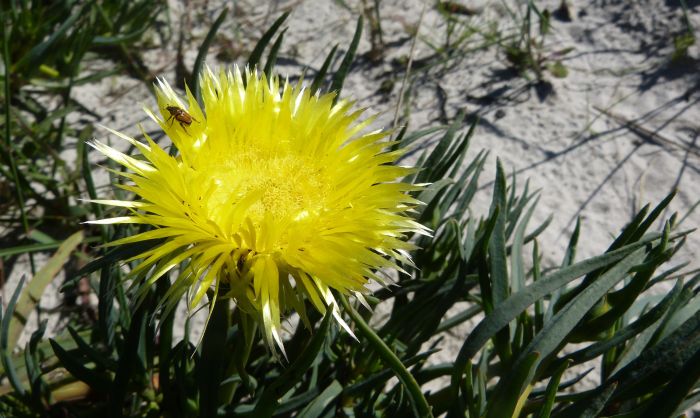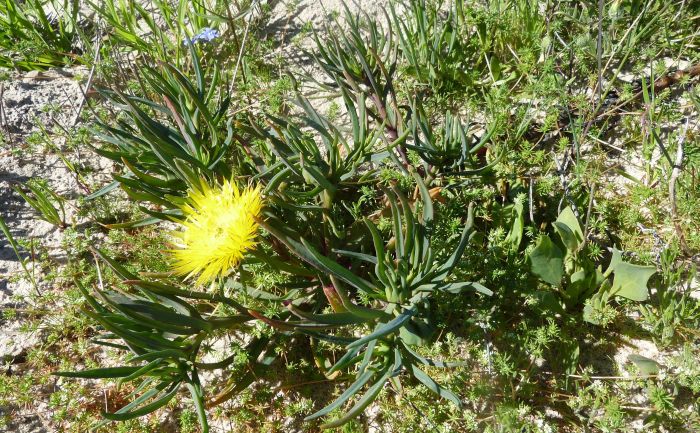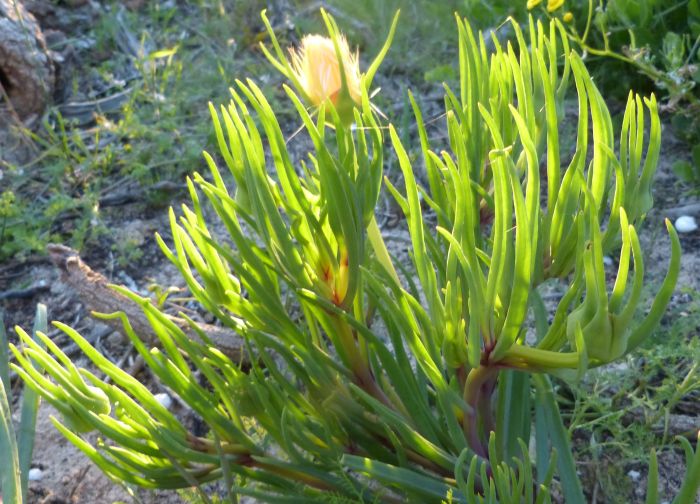Conicosia pugioniformis subsp. pugioniformis
Conicosia pugioniformis (L.) N.E.Br. subsp. pugioniformis
Family: Aizoaceae
Common names: giant clockplant, pigroot, pig salad, narrow-leaved ice plant (Eng.); groot vetkousie, varkslaai, gansies, varkwortel, snotwortel (Afr.)
Introduction
A striking, yellow flowering, die-hard, succulent groundcover, suited to sandy and coastal gardens, rockeries or pots.

Description
Description
Conicosia pugioniformis subsp. pugioniformis is a tufted, fleshy perennial, growing between 120 and 400 mm tall, with a huge tap root and trailing branches. The leaves are smooth and hairless (glabrous), linear, erect, 3-angled (trigonous), keeled and concave above, and are densely arranged.

Large, solitary, yellow flowers on long pedicels, 50–80 mm across, are produced in spring and early summer (from September to December). The flowers have between 200–250 petals, often with long hairs on the lower parts. Several, thin, tangled stamens are at the centre of the flower. Stigmas are free. Fruit is a xerochastic (inducing of fruit dehiscence by means of a drying out process), 10–20-locular, 8–23-chambered capsule. Mericarps form later with seeds enclosed in pockets. Seed is ready for harvest in early to midsummer (from mid-December).

Conservation Status
Status
Conicosia pugioniformis subsp. pugioniformis is not threatened and has a Least Concern (LC) status according to the Red List of South African plants website.
Despite being rarely cultivated, a subspecies (C. pugioniformis subsp muirii), which is naturally found between Cape Agulhas towards Plettenberg Bay in South Africa’s Western Cape Province, has become an invasive weed in parts of Australia (Victoria) and the USA (California).

Distribution and habitat
Distribution description
Conicosia pugioniformis subsp. pugioniformis is found on a long stretch along the west coast of South Africa, from Clanwilliam to Vredendal and Vanrhynsdorp, to areas around Cape Town (Bellville). It is found amongst vegetation types such as Cape Flats Dune Strandveld, Langebaan Dune Strandveld and Saldanha Dune Strandveld, within the Greater Fynbos Biome.

Derivation of name and historical aspects
History
The genus Conocosia is derived from the Greek word konikos, which is in reference to the conical shape of the capsule. The specific epithet pugioniformis relates to the dagger-shaped form of the leaves.
The genus Conicosia consists of 2 species: pugioniformis and elongata. C. elongata, also known as varkslaai or varkwortel, has leaves that are circular to semi-circular in cross section, and it occurs on sandy flats in the Northern Cape, in the Richtersveld and the Karoo to Touws River. The species pugioniformis is made up of 3 subspecies namely: subsp. muirii, subsp. alborosea and subsp. pugioniformis. The subsp. alborosea, has light yellow flowers and occurs in Namaqualand in the Northern Cape. The subsp. muirii has dark yellow flowers and is smaller than the other subspecies, and occurs from Caledon to Knysna, in the Western Cape. These plants show much variation and in the past, some of the variants were described as separate species, however, these variations can be seen in one population and thus there are now only 2 recognised species.
The Afrikaans names of varkslaai (meaning ‘pig salad’) and varkwortel (meaning ‘pig root’), are derived from the fondness of pigs for the rootstock of this plant, and because these plants have been used as pig food. The name snotwortel refers to the way the roots become a slimy, mucus-like mess when soaked in hot water.

Ecology
Ecology
Conicosia pugioniformis is a short-lived, winter-growing perennial. Several insects, including bees and beetles, have been observed visiting the flowers of this species. Seed may be found in their locules, and there are also pockets or chambers in which small seed quantities get encased in woody tissue. Conicosia capsules open once only and do not close again. The fruit is xerochastic, and burst by desiccation and the seeds are dispersed as the lightweight capsules break free and roll along the ground in the wind, scattering their seeds over vast distances. The dispersed seeds remain dormant for several months (or years), and some may germinate at the beginning of the rainy season. Seeds maintain a long viability in the soil and this enables it to ensure perpetuation over time, as well as space.
The seedlings of succulents can develop in different ways: in the genus Conicosia the cotyledons (seed leaves) are elongate and look like the adult foliage.
Mature plants have the ability to expand their root system annually. This enables the formation of a strong taproot, which becomes more swollen and develops into an underground caudex. If severed near the surface, a new stem will emerge the following growing season, from this caudex. This enables them to survive trampling and fires.
Photosynthetic tissues found within the genus Conicosia, are normally close to the surface and surround chlorophyll-free water-storing tissues. This increases conductance of the mesophyll, and, therefore, results in a decrease in the dependence of Crassulacean Acid Metabolism (CAM). This very feature makes highly succulent Aizoaceae perfectly adapted to the wet winters and dry summers of the Succulent-Karoo Region (SKR).
Cysts of the nematode Globodera capensis are frequently detected in the sandy soils of the Sandveld-region. This nematode is the first known indigenous nematode in the genus. Sampling of cleared potato fields, and natural land surrounding some of the fields where opportunistic plants, including C. pugioniformis and Oncosiphon grandiflorum, were found growing, all revealed the presence of this cyst. This indicates that Conicosia may be a host plant, but at present the host plant still needs to be confirmed.
Uses
Use
No medicinal uses have been recorded. The slimy roots and fresh fruits are considered edible and can be cooked in stews. The plants have also been used to feed pigs.

Growing Conicosia pugioniformis subsp. pugioniformis
Grow
Sow seed in late autumn or early winter in a free-draining medium; use either compost or fine river sand to cover the seed. Water with a very fine spray and take great care in ensuring the medium does not get overwatered, but just stays moist. Germination is between 2-3 weeks from freshly harvested and smoke-treated seed. Pot on into well-drained medium once the second set of true leaves has appeared.
Companion plants may include: Arctotis hirsuta, A. stoechadifolia, A. revoluta and A. angustifolia, Pelargonium capitatum, P. fulgidum and P. gibbosum, Lampranthus aureus, L. amoenus and L. roseus, Zygophyllum morgsana and Z. flexuosum, Melianthus elongatus, Malephora crocea, Aloe maculata and A arenicola, Senecio elegans and S. arenarius, Othonna dentata, Anisodontea scabrosa, Carpobrotus quadrifidus, Didelta carnosa and D. spinosa, Freylinia visseri, Ursinia anthemoides, Cotula duckittiae, Cleretum bellidiforme, Dimorphotheca pluvialis, Felicia filifolia and F. elongata, Salvia aurea and S. lanceolata, Tylecodon paniculatus, Cotyledon orbiculata and Curio crassulifolius.
Provided it is grown in a sunny spot, this species does well in pots, rockeries and can be used to stabilise sandy soils.
Conicosia pugioniformis plants are capable of sprouting vegetatively from its caudex, if its above-ground parts are destroyed.
References
- Bleck, J. 2012, Conicosia pugioniformis, in Jepson Flora Project (eds.) Jepson eFlora, http://ucjeps.berkeley.edu/eflora/eflora_display.php?tid=20126, accessed 14/03/2019.
- California Invasive Plant Council (CALIPC) website, Plants A to Z: Conicosia pugioniformis https://www.cal-ipc.org/plants/profile/conicosia-pugioniformis-profile/ Accessed 13/03/2019.
- Chesselet, P. & Van Wyk, A.E. 2002. Mesembryanthemaceae. Mesembs with nut-like schizocarpic fruit and Ruscianthemum sunk under Stoeberia Dinter & Schwantes Friederich. Bothalia 32 (2): 187–190.
- Court, D. 1981. Succulent flora of southern Africa. Balkema, Cape Town.
- El Moro Elfin Forest website, Conservation, Alien Invasion, Part 7: narrow-leaved iceplant. http://www.elfin-forest.org/Library/Conservation/Weed%20Management/PeteWeed/NarrowLeavedIceplant.htm. Accessed 14/03/2019.
- Hartmann, H.E. ed. 2002. Illustrated handbook of succulent plants: Aizoaceae F–Z (Vol. 2). Springer Science & Business Media, Berlin, Heidelberg, New York.
- Herre, H. 1971. The genera of the Mesembryanthemaceae. Tafelberg, Cape Town.
- Klak, C., Hanáček, P. & Bruyns, P.V. 2015. A phylogeny and revised classification for the Apatesiea (Aizoaceae: Ruschioideae) with comparison and centres of diversity. Taxon 64: 507–522.
- Knoetze, R., Malan, A.P. & Mouton, C. 2006. Differentiation of South African cyst nematodes (PCN) by analysis of the rDNA internal transcribed spacer region. African Plant Protection 12: 103–110.
- Knoetze, R., Swart, A. & Tiedt, L.R. 2013. Description of Globodera capensis n. sp (Nematoda: Heteroderidae) from South Africa. Nematology 15: 233–250.
- Leistner, O.A. (ed.). 2000. Seed plants of southern Africa: families and genera. Strelitzia 10. National Botanical Institute, Pretoria.
- Manning, J. & Goldblatt, P. 2012. Plants of the Greater Cape Floristic Region 1: the Core Cape Flora. Strelitzia 29. South African National Biodiversity Institute, Pretoria.
- Operation Wildflower, Mesembs: Conicosia puginioformis https://www.operationwildflower.org.za/index.php/albums/mesembs/conicosia-pugio. Accessed13/03/2019.
- Rowley, G. 1978. The Illustrated Encyclopedia of Succulents. Crown Publishers, New York.
- Seeds for Africa, Conicosia puginioformis pages 1-9 https://www.seedforafrica.ca.za/products/conicosia-indigenous-south. Accessed 13/03/2019.
- Smith, C.A. 1966. Common names of South African plants. Memoirs of the Botanical Survey of South Africa No. 35. Government Printer, Pretoria.
- Stearn, W. 2002. Stearn's dictionary of plant names for gardeners. Timber Press, Portland, Oregon.
- SucculentGuide.com, Genus: Conicosia https://www.succulentguide.com/cactus/?genus=Conocosia. Accessed 14/03/2019.
- Trinder-Smith, T.H. 2006. Wild flowers of the Table Mountain National Park. Botanical Society, Cape Town.
- Van Wyk, B.-E. & Gericke, N. 2000. People's plants. Briza Publications, Pretoria.
Credits
Roger Oliver
Kirstenbosch National Botanical Garden
September 2019
Acknowledgements: the author thanks Ernst van Jaarsveld for all photographs supplied.
Plant Attributes:
Plant Type: Ground Cover, Succulent
SA Distribution: Northern Cape, Western Cape
Soil type: Sandy
Flowering season: Spring, Early Summer
PH: Acid, Alkaline, Neutral
Flower colour: Yellow
Aspect: Full Sun
Gardening skill: Easy
Special Features:
Horticultural zones









Rate this article
Article well written and informative
Rate this plant
Is this an interesting plant?
Login to add your Comment
Back to topNot registered yet? Click here to register.